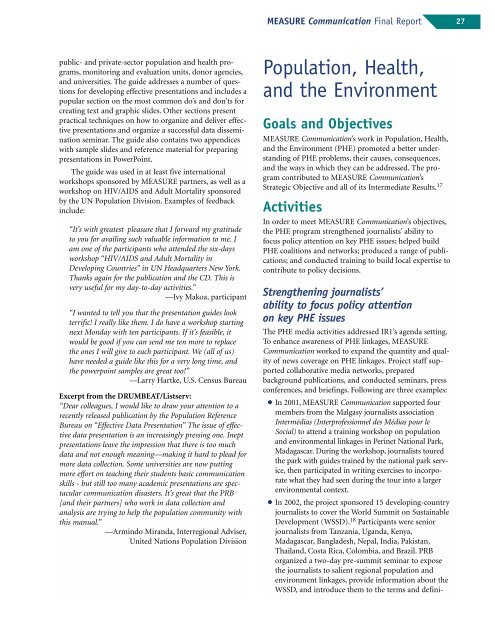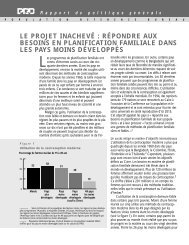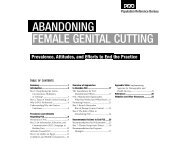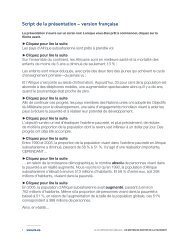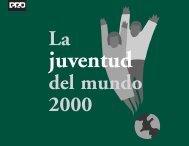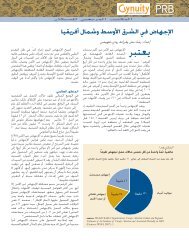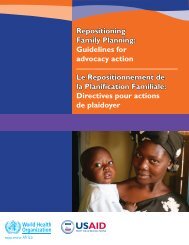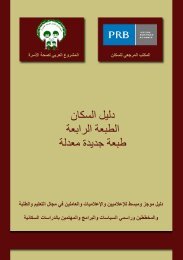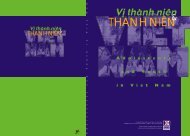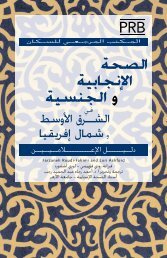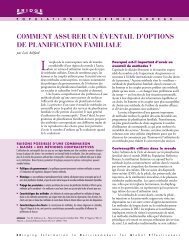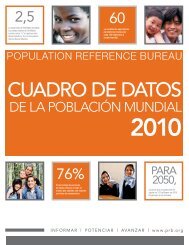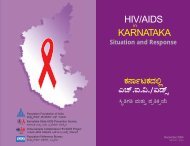MEASURE Communication Final Report - Population Reference ...
MEASURE Communication Final Report - Population Reference ...
MEASURE Communication Final Report - Population Reference ...
Create successful ePaper yourself
Turn your PDF publications into a flip-book with our unique Google optimized e-Paper software.
<strong>MEASURE</strong> <strong>Communication</strong> <strong>Final</strong> <strong>Report</strong><br />
27<br />
public- and private-sector population and health programs,<br />
monitoring and evaluation units, donor agencies,<br />
and universities. The guide addresses a number of questions<br />
for developing effective presentations and includes a<br />
popular section on the most common do’s and don’ts for<br />
creating text and graphic slides. Other sections present<br />
practical techniques on how to organize and deliver effective<br />
presentations and organize a successful data dissemination<br />
seminar. The guide also contains two appendices<br />
with sample slides and reference material for preparing<br />
presentations in PowerPoint.<br />
The guide was used in at least five international<br />
workshops sponsored by <strong>MEASURE</strong> partners, as well as a<br />
workshop on HIV/AIDS and Adult Mortality sponsored<br />
by the UN <strong>Population</strong> Division. Examples of feedback<br />
include:<br />
“It’s with greatest pleasure that I forward my gratitude<br />
to you for availing such valuable information to me. I<br />
am one of the participants who attended the six-days<br />
workshop “HIV/AIDS and Adult Mortality in<br />
Developing Countries” in UN Headquarters New York.<br />
Thanks again for the publication and the CD. This is<br />
very useful for my day-to-day activities.”<br />
—Ivy Makoa, participant<br />
“I wanted to tell you that the presentation guides look<br />
terrific! I really like them. I do have a workshop starting<br />
next Monday with ten participants. If it’s feasible, it<br />
would be good if you can send me ten more to replace<br />
the ones I will give to each participant. We (all of us)<br />
have needed a guide like this for a very long time, and<br />
the powerpoint samples are great too!”<br />
—Larry Hartke, U.S. Census Bureau<br />
Excerpt from the DRUMBEAT/Listserv:<br />
“Dear colleagues, I would like to draw your attention to a<br />
recently released publication by the <strong>Population</strong> <strong>Reference</strong><br />
Bureau on “Effective Data Presentation” The issue of effective<br />
data presentation is an increasingly pressing one. Inept<br />
presentations leave the impression that there is too much<br />
data and not enough meaning—making it hard to plead for<br />
more data collection. Some universities are now putting<br />
more effort on teaching their students basic communication<br />
skills - but still too many academic presentations are spectacular<br />
communication disasters. It’s great that the PRB<br />
[and their partners] who work in data collection and<br />
analysis are trying to help the population community with<br />
this manual.”<br />
—Armindo Miranda, Interregional Adviser,<br />
United Nations <strong>Population</strong> Division<br />
<strong>Population</strong>, Health,<br />
and the Environment<br />
Goals and Objectives<br />
<strong>MEASURE</strong> <strong>Communication</strong>’s work in <strong>Population</strong>, Health,<br />
and the Environment (PHE) promoted a better understanding<br />
of PHE problems, their causes, consequences,<br />
and the ways in which they can be addressed. The program<br />
contributed to <strong>MEASURE</strong> <strong>Communication</strong>’s<br />
Strategic Objective and all of its Intermediate Results. 17<br />
Activities<br />
In order to meet <strong>MEASURE</strong> <strong>Communication</strong>’s objectives,<br />
the PHE program strengthened journalists’ ability to<br />
focus policy attention on key PHE issues; helped build<br />
PHE coalitions and networks; produced a range of publications;<br />
and conducted training to build local expertise to<br />
contribute to policy decisions.<br />
Strengthening journalists’<br />
ability to focus policy attention<br />
on key PHE issues<br />
The PHE media activities addressed IR1’s agenda setting.<br />
To enhance awareness of PHE linkages, <strong>MEASURE</strong><br />
<strong>Communication</strong> worked to expand the quantity and quality<br />
of news coverage on PHE linkages. Project staff supported<br />
collaborative media networks, prepared<br />
background publications, and conducted seminars, press<br />
conferences, and briefings. Following are three examples:<br />
● In 2001, <strong>MEASURE</strong> <strong>Communication</strong> supported four<br />
members from the Malgasy journalists association<br />
Intermédias (Interprofessionnel des Médias pour le<br />
Social) to attend a training workshop on population<br />
and environmental linkages in Perinet National Park,<br />
Madagascar. During the workshop, journalists toured<br />
the park with guides trained by the national park service,<br />
then participated in writing exercises to incorporate<br />
what they had seen during the tour into a larger<br />
environmental context.<br />
● In 2002, the project sponsored 15 developing-country<br />
journalists to cover the World Summit on Sustainable<br />
Development (WSSD). 18 Participants were senior<br />
journalists from Tanzania, Uganda, Kenya,<br />
Madagascar, Bangladesh, Nepal, India, Pakistan,<br />
Thailand, Costa Rica, Colombia, and Brazil. PRB<br />
organized a two-day pre-summit seminar to expose<br />
the journalists to salient regional population and<br />
environment linkages, provide information about the<br />
WSSD, and introduce them to the terms and defini-


